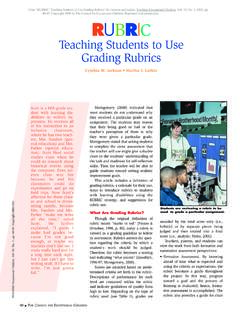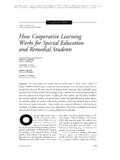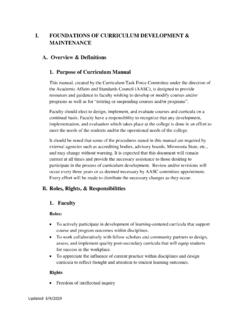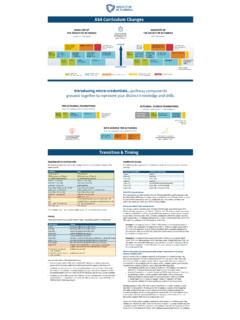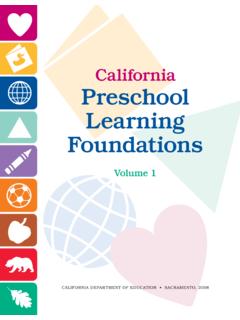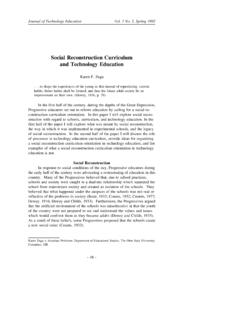Transcription of Foundations of Education Syllabus - casenex.com
1 Foundations of Education Syllabus Course Description This course provides an overview of the cultural, sociological, political, and historical underpinnings of the American Education system. Participants will review local, state, and national policy, legislation, and regulations pertaining to PreK-12 Education . Participants will reflect upon how these concepts drive instructional practices in today's challenging classroom environment. Using the cases as a launching point, teachers will be given opportunities to engage in online discussions, journal reflections, and workbook assignments focusing on beliefs, best practices, challenges, current research, and classroom applications. Competencies Upon completion of this course, participants will be able to: Explain the impact of population shifts and the importance of cultural proficiency in relationship to public Education systems Discuss the connection between public schools and sociological issues and trends Describe the important political issues that influence public Education at the Federal, State and Local levels Apply knowledge about the evolving model of public Education by considering historical and current perspectives on school reform and Address contemporary issues in Education including developing methods for appropriately integrating technology within the parameters of differentiated instruction.
2 Materials All materials are accessed via the CaseNEX website using the PIN. provided and the user name/password you create. All readings listed can be found by going to Class Materials Virtual Library Readings (Search). 1. If you do not have the most recent versions of the following software, please download each from the given sites. Windows Media Player RealPlayer Adobe Reader QuickTime Cases Used Change Can Be A Challenge Dealing With Data Let Us Pray Measure Up What's Happening Course requirements and grades Course Schedule Find session dates by selecting Syllabus on the top menu bar. For typical courses, final Discussions, Journals, and Workbooks are due by Saturday at midnight unless otherwise noted. Please see the News Flash for any alterations of the course schedule posted by your instructor.
3 2. Introductory Session Exploring the CaseNEX Site Complete these tasks prior to the beginning of Session 1. Readings Read the course requirements, paying special attention to the Case- Analysis and Workbook Assignment Rubrics. They will be used by your instructor throughout the course to evaluate assignments where appropriate. Discussion Post one entry introducing yourself to your classmates. You may choose to describe your professional background and experience, relevant personal information, or why you are taking this course. (100. words or fewer). Journal What do you find inspiring and challenging about your work in Education ? (100 words or fewer). Note Use CaseMail to send a note to your instructor stating that you will be taking this course. To do so, click on CaseMail on the top menu bar and then Click here to create a new message.
4 ' Use the marked link to look up an address. Continue linking down until you see the class list. Select the instructor's name and then compose your message and hit Post Message.'. 3. Session 1. Understanding Culture, Equity, and Multicultural Influences Case What's Happening? Readings US Census Bureau Projections of the Resident US Population by Race, Hispanic Origin, and Nativity US Census Bureau Projections of State Populations, by Sex, Race, and Hispanic Origin US Census Bureau poverty data Cultural Proficiency (read introduction and the Assessment Scales and Culturally Proficient Schools links). Seven Key Characteristics of a Multicultural Education Curriculum Discussion In which ways do you identify with the teachers and issues depicted in the case? Pick the scene that seems most familiar to you from scenes 1, 3, 5, or 6.
5 Based on the knowledge gained from this session's reading, determine where the teacher in the scene is on the Cultural Proficiency Assessment Scales. How might this teacher's Education , family, and professional experiences have shaped his or her perspective? What actions might the teacher take to increase his or her cultural proficiency? Journal How do the demographics of your school compare to national and state US Census Bureau figures? Describe actions suggested by these population shifts and their possible consequences for your classroom and school community. Note Check your CaseMail (linked from top menu bar) and News Flash (on the right when you login) for notes from your instructor every time you log on to the site. Workbook 4. None this session 5. Session 2. Recognizing Sociological Influences Case Let Us Pray Readings Social and Economic Context Ethical Leadership Guidance on Constitutionally Protected Prayer in Public Elementary and Secondary Schools Discussion Apply knowledge gained from the Guidance on Constitutionally Protected Prayer in Public Elementary and Secondary Schools reading.
6 Discuss the perspectives of the students' and Principal Estment. Propose the possible consequences of the character's actions in the case, including long-term, intended and unintended consequences. Journal Society in conjunction with its social trends and issues has a direct influence on the public Education systems in the United States. Reflect on the social issues faced by students you currently teach or have worked with in the past. What actions has your school or district taken to address these issues? In what ways did the actions of school leaders reflect the principles discussed in the reading Ethical Leadership ? Workbook Case Analysis Using either the scene of your choice from What's Happening or the case Let Us Pray, complete a formal case analysis. Address each of the 5-Steps in turn, referring to the Course Tutorial and the Case- Analysis Rubric to guide your thinking.
7 6. Session 3. Understanding the Legal Foundation of Public Education Case Let Us Pray Readings FindLaw Education Law Section The National School Boards Association School Law Issues Web Page The Supreme Court and Public Schools Discussion After reading Ryan's The Supreme Court and Public Schools, . summarize the difference between how the Court approaches applying the Equal Protection, Establishment, and Free Exercise Clauses in the public school setting and how it applies free speech, Fourth Amendment privacy, and due process rights in the public schools. Discuss your perspective on the extent to which you believe these differing approaches are warranted and whether you agree with the distinctions the Supreme Court has drawn. Journal Describe specific legal issues your school or district has confronted.
8 What actions were taken to resolve them? What was the final outcome? Explain the subsequent consequences (both positive and negative). What has been the affect of these issues on the daily business of your school or district? Workbook Assignment What Educators Should Know Choose from the following list of topics and post your choice in your journal by the end of this session. (Please note this assignment has two due dates. The actual assignment is due by the end of Session 7 as indicated below). Eligibility under IDEA. Individual Education Plans under IDEA. 7. Discipline and IDEA. Section 504 Eligibility Process Search and Seizure Title IX Selected Controversies Termination of Teachers Sexual Harassment (Adult to Adult, Adult to Student, Student to Student). Student Expression Internet/Technology Legal Controversies Athletics and Extracurricular Activities Selected Controversies Free Exercise and Establishment Clause Issues Curriculum and Instruction Employment Discrimination Teachers' Rights of Expression, Association, and Privacy Student Records FERPA.
9 Employment Licensure, Pre-employment Issues, Contracts, Assignments and Tenure Employment Grievance Procedures and Resulting Controversies School Vouchers Charter Schools This assignment is designed to give each course participant the opportunity to gain some depth of understanding in one area of school law and then to serve as a resource for the entire class. Research your topic and prepare a short (no longer than the equivalent of 1250 words). briefing paper on what educators need to know about the area of law you choose. Pay close attention to the issues involved: recent trends, controversies, new developments, and circumstances in your state. On the due date, you will post the paper on the discussion board and in your Workbook. Depending on the topic, you may choose to give a comprehensive overview of an area with general guidelines for practice, or you may examine selected issues after a brief overview.
10 You may also break down a topic into a component part, if you find that it is too broad for purposes of the assignment. On the other hand, you may expand on topic by relating the content to a specific controversy of interest that is illustrative of a larger legal trend or principle. Where appropriate, you may focus on state laws or local school division policies. Topic selection due by the end of this session. Briefing paper due by the end of Session 7. 8. Session 4. Recognizing the Federal Role in Education Case None this session Readings Interstate School Leadership Licensure Consortium: Standards for School Leaders Standards 5. The Education Agenda from the White House Discussion Based upon the reading and your experiences, what do you consider to be the most important research-based factors in helping students develop literacy?

